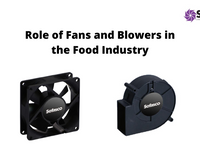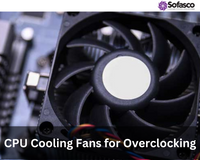In the world of 3D printing, precision, reliability and material performance are key. One often overlooked but critically important component in achieving high-quality prints is cooling. Whether you're printing functional parts, prototypes, or artistic models, an effective 3D printer cooling system can dramatically improve print outcomes. In this guide, we’ll explore the role of compact cooling fans in 3D printing, including 3D printer part cooling fans, 3D print blower fans and 3D printer enclosure cooling solutions.
Why Is a Cooling System Important for 3D Printing?
During the extrusion process, the filament is heated to a semi-liquid state to be shaped into the desired form. However, if not cooled properly, this molten material can warp, sag, or lose definition. Here's why cooling systems in 3D printing matter:
- Layer adhesion: Controlled cooling solidifies each layer quickly, enhancing inter-layer bonding.
- Surface finish: Faster solidification results in a smoother finish and fewer defects.
- Dimensional accuracy: Uniform cooling prevents warping and improves structural integrity.
- Print speed optimization: Efficient cooling enables faster print speeds without compromising quality.
Whether you're a hobbyist or a commercial user, integrating the right 3D printer cooling fan ensures a more efficient and consistent 3D printing process.
3D Printer Cooling Fans Offered by Sofasco™ International
Sofasco™ International proudly manufactures a range of high-performance cooling fans optimized for 3D printers. Designed to handle high temperatures, dust and continuous use, our fans support efficient airflow, quiet operation, and long service life. We offer several fan types tailored for various components and environments within 3D printers.
-
Axial Fans: Axial fans are commonly used for hotend (heatsink) cooling, mainboard ventilation, and general enclosure airflow. These fans are available in both 12V and 24V DC versions, allowing compatibility with a wide range of 3D printer models, from desktop hobbyist printers to industrial-grade systems.
- Radial (Blower) Fans: Ideal for part cooling, radial blower fans provide a concentrated stream of air that rapidly cools the extruded filament. Our blower fans are typically offered in 12V or 24V DC configurations to suit both consumer and professional 3D printers.
- Cross Flow Fans: Used primarily in enclosed 3D printers, cross flow fans deliver wide, even airflow across the electronics or print chamber. These fans are manufactured in 12V and 24V DC variants, providing flexible integration options depending on your system's power requirements.
-
Chip Coolers: Designed for cooling tightly packed electronics such as stepper drivers or power modules, our chip cooler fans are available in 5V, 12V, and 24V DC versions. These options ensure efficient thermal control across different printer architectures, from compact boards to high-wattage industrial setups.
- Case (Chassis) Fans: For general ventilation and enclosure cooling, our axial case fans are widely used in sizes like 60mm, 80mm, and 120mm. We offer these fans in both 12V and 24V DC models to support various 3D printer designs and airflow needs.
All of our fans are engineered for durability, quiet operation, and optimal performance, even in demanding 3D printing environments involving high heat, moisture, or particulate exposure.
How to Keep Your 3D Printer Cool?
Keeping your 3D printer cool is essential for consistent performance, long-term reliability, and high-quality prints. Start by installing high-efficiency 3D printer cooling fans, including part cooling fans and mainboard or stepper motor fans, to manage heat at critical points. Ensure your fans are rated for your system’s voltage such as a 24V 3D printer fan and position them for optimal airflow. To cool your 3D printer effectively, follow these essential tips:
- Install a part cooling fan: A 3D printer part cooling fan improves overhangs and bridges by cooling extruded filament instantly.
- Use enclosure cooling: For enclosed printers, integrate a 3D printer enclosure cooling system to manage internal temperatures.
- Add heat sink fans: Keep your stepper motors and hotend components stable with small axial fans.
- Optimize airflow: Make sure air is being directed efficiently to avoid turbulence or dead zones.
- Consider dual-fan setups: In complex prints, using both an axial and radial fan provides comprehensive airflow coverage.
Ventilation Considerations for 3D Printing
Proper ventilation is essential to manage heat, especially when using enclosed printers or working in confined spaces. Here's how to improve ventilation:
- Use filtered fans to maintain air quality.
- Implement exhaust systems for enclosed setups.
- Opt for low-noise fans (like those manufactured by Sofasco) to maintain a quiet working environment while ensuring airflow.
- Monitor ambient room temperature to prevent overheating during longer print sessions.
What Does a Cooling Fan Do in a 3D Printer?
A cooling fan in a 3D printer serves multiple purposes:
- Part cooling: Quickly solidifies the extruded filament, preventing stringing and ensuring crisp details. Consistent cooling reduces blobs, drooping, and deformation in fine features or complex geometries.
- Component cooling: Prevents internal electronics from overheating during long or high-speed prints. Cooling fans protect the printer's components, reducing the risk of thermal damage and extending their lifespan.
- Air circulation: Ensures even temperature distribution by preventing hotspots inside the printer. Balanced airflow promotes uniform layer bonding and stabilizes thermal gradients, especially in extended or multi-material prints.
- Improved overhang and bridge performance: Cooling fans help maintain structural integrity when printing overhangs and bridges by solidifying filament mid-air. Without proper cooling, these features risk sagging or collapsing during printing.
- Enhanced print adhesion control: Proper cooling prevents excessive heat retention, reducing warping and curling in upper layers. Gradual cooling helps manage internal stresses, especially for materials like PLA and PETG.
- Increased print speed potential: Optimized cooling allows for faster print speeds without compromising quality. Rapid layer solidification enables quicker deposition of the next layer, improving overall prototyping cycles.
Choosing the Right Cooling Fan for Your 3D Printer: Key Considerations
When choosing a cooling fan for your 3D printer, especially from a trusted manufacturer like Sofasco, known for high-performance and reliable fan solutions, it's essential to evaluate several technical and functional attributes. Each of these characteristics plays a vital role in the fan’s efficiency, compatibility, and long-term performance in demanding 3D printing environments.
- Airflow Efficiency: Measured in CFM, airflow indicates how much air a fan moves. Sofasco fans ensure consistent, directional flow for enclosure or part cooling in 3D printing.
- Fan Speed (RPM): RPM impacts how fast air circulates; higher speeds mean more airflow but potentially more noise. Sofasco fans are tuned for both performance and quiet operation.
- Operational Longevity (Useful Life): Sofasco fans feature durable ball or sleeve bearings, delivering extended life for long 3D print jobs with reduced maintenance.
- Voltage Compatibility: Designed for 12V and 24V systems, Sofasco DC fans ensure seamless integration with a wide range of 3D printers, supporting efficient cooling.
- Nominal Current: With low current draw, Sofasco fans offer strong airflow while minimizing power usage, ideal for compact and energy-sensitive setups.
- Build Quality & Material Integrity: Built with high-grade materials, Sofasco fans resist vibration and heat, providing stable, long-term cooling in demanding conditions.
Whether you're building a 3D printer from scratch or upgrading your current cooling setup, selecting the right fans is essential for performance and longevity. At Sofasco, we offer low-noise, high-efficiency AC/DC axial and blower fans specifically designed for compact, high-demand environments, just like your 3D printer. Our 24V 3D printer fans and custom cooling solutions ensure thermal management that supports the most precise, reliable prints.
Explore our range of compact cooling fans for 3D printers at Sofasco, and take your 3D printing performance to the next level. Contact us today to find the perfect cooling solution for your needs!
Frequently Asked Questions (FAQ):
-
How do I ventilate my 3D printer?
Use filtered intake and exhaust fans, maintain ambient room temperature, and ensure proper spacing around your printer for airflow.
-
What does the cooling fan do in a 3D printer?
It rapidly cools the extruded filament and internal components, contributing to consistent layer formation, improved detailing, and reduced print defects.
-
Can I use a 24V fan in my 3D printer?
Yes, if your printer supports 24V input, these fans offer better airflow and durability, making them ideal for professional or high-speed printing environments.












